Fizban’s Treasury of Dragons arrives October 26 and will be chock-full of our favorite scaled monsters and their minions. The book will provide a deep dive into the First World, a place that existed before the multiverse and that is the birthplace of dragons. It will also formally bring gem dragons to fifth-edition Dungeons & Dragons!
Gem dragons come in five types: amethyst, crystal, emerald, sapphire, and topaz. The sapphire dragon and a brief history of gem dragons first appeared in fifth edition in an exclusive monster stat block released to benefit Extra Life, a charity that helps sick and injured children.
Find out what we know about gem dragons and their history below:
Share your purchased books with friends!
D&D Beyond is an official toolset for fifth-edition Dungeons & Dragons. Master-tier subscribers can not only create unlimited characters but also share books they've purchased with players in their campaigns and get early access to tools that make playing D&D easier!
The 5 types of gem dragons
The release of the adult sapphire dragon provided us with a glimpse of what we can expect this edition's of gem dragons to be like. Here are common traits among the gem dragons:
- Psionic: What sets gem dragons apart from their metallic and chromatic counterparts are their innate psionic abilities. Telepathy is commonplace among gem dragons, and some hone their psychic abilities to greater effect. An adult sapphire dragon, for example, can innately cast scrying and telekinesis.
- Solitary: Gem dragons don't have a tendency of surrounding themselves with others, even with those of their own kind. In general, they prefer not to meddle or be meddled with.
- Charismatic: Those who deal with these types of dragons will often find them to be charming and great conversationalists.
- Followers of Sardior: Where metallic dragons follow Bahamut the Platinum Dragon and chromatic dragons follow Tiamat the Dragon Queen, gem dragons follow the uniquely ruby dragon Sardior.
- Enemies of aberrations: Gem dragons abhor mind flayers, aboleths, and other aberrations. They help protect the Material Plane from the Far Realm, an alien place that exists beyond the multiverse.
Beyond this, our understanding of gem dragons stems from previous editions of D&D. What we cover below is largely based on lore from D&D 3.5's Monster Manual II and Draconomicon. In this previous edition, gem dragons made their lairs in the Elemental Planes as well as in specific environments in the Material Plane.
Amethyst dragons
The amethyst dragon has scales that appear as crystals. They are wise, majestic, and agreeable. Owed to their temperament, they have at times served as intermediaries between warring dragons and even factions of other intelligent creatures. Owed to their ability to burrow, amethyst dragons tend to carve out lairs deep underground and are known to dwell in the Elemental Plane of Earth.
Amethyst dragons prefer to avoid conflict, even if encountered in their lair. However, if they feel the need to protect themselves, their young, or their territory, they will act with care. Should the tides of battle turn against them, an amethyst dragon is likely to flee, finding little value in fighting to certain death.
Crystal dragons
The crystal dragon has scales that appear as translucent crystals. They are curious and the friendliest of the gem dragons, and make their homes on the Material Plane high atop snowy mountains or in the Elemental Plane of Air. Because white dragons sometimes encroach on their territory (or vice versa), crystal and white dragons occasionally war with one another. Such battles are most often instigated by white dragons; crystal dragons care little for needless fighting.
That's not to say crystal dragons are blameless. They are known to steal white dragon eggs on occasion and raise their young to be good. Should you chance upon a crystal dragon lair, though, you would find an icy palace decorated with finely crafted ice sculptures. Owed to their friendly nature, crystal dragons are unlikely to attack at first sight. They prefer conversing with adventurers and avoiding those who are problematic.
Emerald dragons
With scales that range in tones of green from emerald to sea green and mint, emerald dragons are a sight to behold. These inquisitive and highly intelligent dragons commonly take an interest in the history and customs of civilizations they dwell near. For any wizard, playing trivia against an emerald dragon is a true test of one's knowledge. Unfortunately, these dragons are paranoid and don't care much for having tea with strangers.
Emerald dragons commonly make their lairs just beyond the boundaries of civilization, preferring the cones of active or inactive volcanoes. Though they might also make the Inner Planes their home, emerald dragons are careful to keep a close eye on any lairs they have on the Material Plane. They are prone to use mundane and magical traps and alarms in order to avoid trespassers from catching them unawares.
Despite their wariness, emerald dragons are anything but fearful. They are unafraid of going toe to toe with enemies in melee range, though they aren't reckless. They might use spells such fog cloud before unleashing their breath weapon to soften up enemies. These dragons are also known to go hunting for treasure on the seas. They will herd ships to a location where it can safely examine and loot cargo.
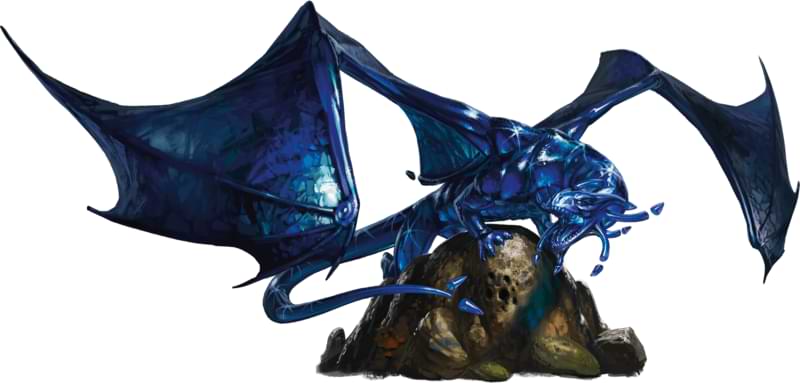
Sapphire dragon
Sapphire dragons are the only gem dragons that have thus far been released in fifth edition. We know that their scales glitter and are various shades of blue, and that they are fiercely territorial and warlike. They dwell deep underground and are master tacticians, preferring to take their time studying enemies and planning ambushes rather than committing to a frontal assault.
If you have hopes of hunting down a sapphire dragon — good luck. Their lairs can be impossible to find. Sapphire dragons can shape stone (represented in their lair actions), and will seal off all entrances into their lair.
In D&D 3.5, these dragons commonly warred with creatures of the Underdark, including drow and mind flayers, and kept their heads as trophies. In addition to dwelling on the Material Plane, they also made their homes in the Elemental Plane of Earth. Adventurers who visit a sapphire dragon in their lair would be wise to bring a game of strategy for entertainment — and let them win.
Topaz dragon
A topaz dragon's individual yellow and orange scales can be hard to spot at a distance, making the creature appear as though it were sculpted from a single, enormous gem. Yet, this dragon's temperament betrays its beauty. Topaz dragons are unfriendly, selfish, and erratic. A chance encounter could start as friendly and cheery but then quickly devolve into a battle. In some way, their behavior is akin to the eladrin of the Feywild.
In the Material Plane, topaz dragons make their home near secluded beaches or in underwater caves. There, they feast on aquatic creatures like sharks and squids. They're also known to inhabit the Elemental Plane of Water.
What about obsidian dragons?
Technically, there is a sixth type of gem dragon: the obsidian dragon. These were the cruelest and most intelligent of the gem dragons. They enjoyed making their prey suffer and made their homes in volcanos in the Material Plane and in the Elemental Plane of Fire. However, these dragons aren't mentioned in the adult sapphire dragon's statistics page, so they are not discussed at length here. My guess is that they won't appear in Fizban’s Treasury of Dragons.
Sardior, the god of gem dragons
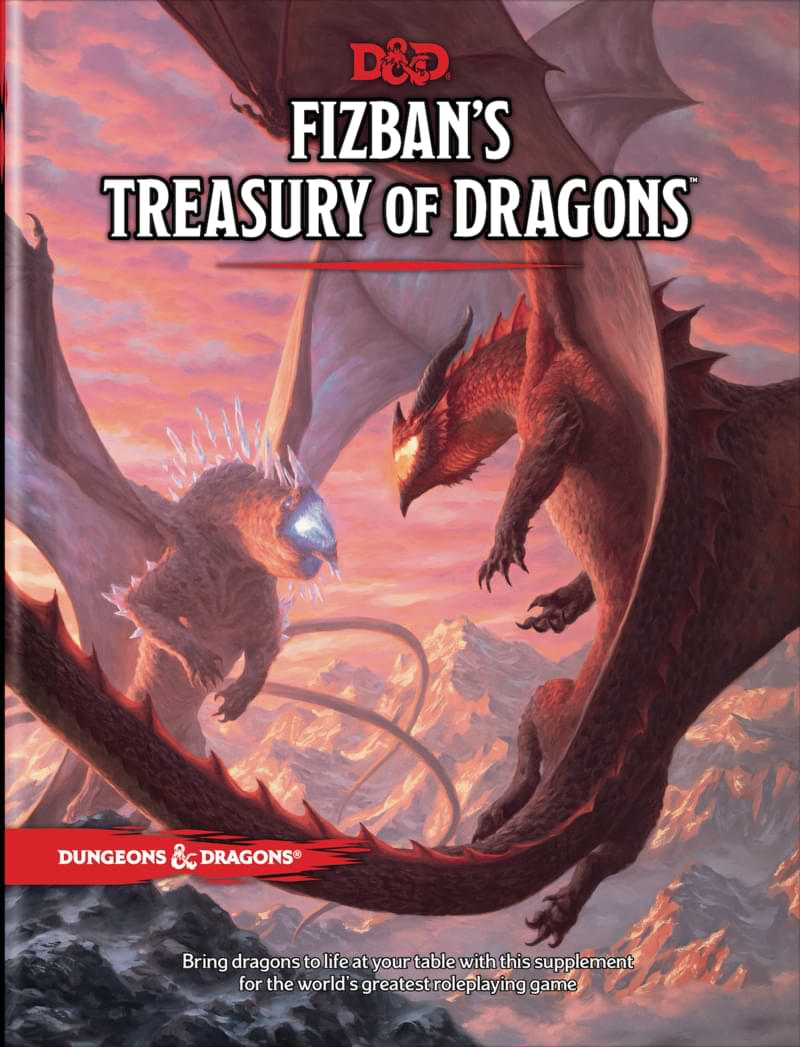 Where Bahamut and Tiamat preside over metallic and chromatic dragons, respectively, another deity watches over gem dragons: Sardior, the ruby dragon.
Where Bahamut and Tiamat preside over metallic and chromatic dragons, respectively, another deity watches over gem dragons: Sardior, the ruby dragon.
In fifth-edition lore, the mysterious Sardior dwells in a floating city made of ruby and red gold that can only be spotted at night. He keeps a council of five ancient gem dragons, one of each kind. Sound familiar? When Bahamut is in his human form, he is accompanied by seven golden canaries — each an ancient gold dragon in polymorphed form.
In playtest material released for new draconic ancestries for dragonborn, Sardior is mentioned in passing. He is said to have been the first creation of Bahamut and Tiamat in the First World.
What we know about the First World
The First World hasn't seen much mention in fifth-edition D&D. Tasha's Cauldron of Everything briefly discusses the First World in an aside following the spell dream of the blue veil:
Traveling to other worlds
The Material Plane holds an infinite number of worlds. Some—like Oerth, Toril, Krynn, and Eberron—are well documented, but there are countless others. You and your friends may even have created some homemade D&D worlds yourselves!
It was not always so. Various scholars speak of a primordial state, a single reality they call the First World, which preceded the multiverse as we know it. Many of the peoples and monsters that inhabit the worlds in the Material Plane originated there. After the First World was shattered by a great cataclysm—giving birth to the worlds that came in its wake—the progeny of the first elves, dwarves, beholders, and other iconic creatures took root on world after world, like seeds scattered by a cosmic wind. If the musings of these great sages are true, every world is a reflection—and in some cases, a distortion—of the First World.
Source: Tasha's Cauldron of Everything
From previous editions of D&D, we know the First World is a place that the primordial gods used as a testing ground for their creations. It is a chaotic place, with even the laws of nature like gravity and light being unpredictable. At times, a small area of the First World might become stable and predictable, but this is sure to be short-lived. Chaos is the default state for the First World.
What is Fizban's Treasury of Dragons?
Fizban's Treasury of Dragons is now available for preorder on D&D Beyond! The book adds new player options, including draconic ancestries for dragonborn, dragon-themed monk and ranger subclasses, as well as feats and spells. Learn all about 20 different kinds of dragons and their minions. Dungeon Masters will enjoy the included lair maps and the rich lore behind the First World and more! Those with a Master-tier subscription can share books they've purchased with players in their campaigns.
Michael Galvis (@michaelgalvis) is a tabletop content producer for D&D Beyond. He is a longtime Dungeon Master who enjoys horror films and all things fantasy and sci-fi. When he isn’t in the DM’s seat or rolling dice as his anxious halfling sorcerer, he’s playing League of Legends and Magic: The Gathering with his husband. They live together in Los Angeles with their adorable dog, Quentin.








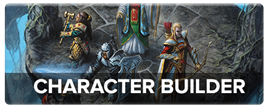
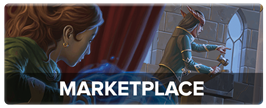
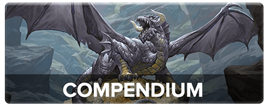
-
View User Profile
-
Send Message
Posted Jul 16, 2021Interested to see what they do with the Gem Dragons. I haven't used them in any of my games in previous editions.
-
View User Profile
-
Send Message
Posted Jul 16, 2021Excited to see the new backgrounds for the Monk and Ranger!
-
View User Profile
-
Send Message
Posted Jul 16, 2021Nice! I just read about this book yesterday and wanted to know more, and here it is!
-
View User Profile
-
Send Message
Posted Jul 16, 2021So obsidian dragons just don’t exist? That’s funny
-
View User Profile
-
Send Message
Posted Jul 16, 2021Yes it is. I was going to mention that but it slipped my mind.
EDIT: I don't know why they would just cut it out, especially in this book, which might be a little on the small side compared to others.
-
View User Profile
-
Send Message
Posted Jul 16, 2021"Should the tides of battle turn against them, an amethyst dragon is wont to flee,"
Think you may have made a spelling/grammar error here.
-
View User Profile
-
Send Message
Posted Jul 16, 2021I mean... sure? A whole book on dragons. I guess.
How about a book to help new DMs. Maybe new settings books. Maybe allow more Novels to be written.
Seems a bit niche to me.
Maybe in another 5 months we'll get an equally focused book on Goblinkin.
Here are a few ideas that would be nice to see: Dark Sun settingbook, Spelljammer setting book, books on class lore, psionic class, books on the other realms (eg: far realm, celestia, pandamonium), let authors write novels again... not more Drizzt please.
-
View User Profile
-
Send Message
Posted Jul 16, 2021Hopefully they're including the updated Dragonborn and Kobold races.
-
View User Profile
-
Send Message
Posted Jul 16, 2021So... psychic space dragons who want to destroy other psychic space beings?
I like it.
I really like it.
Can't wait for this book to come out!
-
View User Profile
-
Send Message
Posted Jul 16, 2021What? This is the book most of us have been wanting!
-
View User Profile
-
Send Message
Posted Jul 16, 2021Honestly, a setting book is a little bit niche as well, and the majority of people won't get it. Goblinkin were in Volo's, so they won't be getting book anytime soon. a planar realm would be awesome, but I don't see it happening. The dungeon masters guide is the DM book, and it contains things for all levels of experience, and a book for new DMs is extremely niche and would be one of those things that you buy and then use once at most.
-
View User Profile
-
Send Message
Posted Jul 16, 2021Why would they not be included?
-
View User Profile
-
Send Message
Posted Jul 16, 2021Yah. I can't believe they didn't come in with Volo's.
-
View User Profile
-
Send Message
Posted Jul 16, 2021YAY!!!!!!!!!!!!!!!!!!!!!!!!!!!!!!!!!!!!!!
-
View User Profile
-
Send Message
Posted Jul 16, 2021I almost completely disagree with you. I do agree with "what would [also] be nice to see", except for the "not more Drizzt, please". There wasn't anything about dragon lore in Volo's or Mordenkainen's, so it seems to make sense that they would do a focused book on dragons. I already completely love this book. I'd personally like to see: a book about all the other planes (obviously mostly not about the Material), bring back some classic settings, and of course, in addition, more novels. Including Drizzt (the only D&D novels I've read so far). Just my opinion, of course.
-
View User Profile
-
Send Message
Posted Jul 16, 2021nitipick: You misspelled "meddle" as "mettle"
-
View User Profile
-
Send Message
Posted Jul 16, 2021They exist, but the Obsidian dragon that was once in Sardior's court, Seradess, he killed. They are more or less not even governed by Sardior anymore as he banished all of them.
-
View User Profile
-
Send Message
Posted Jul 16, 2021Words hard. (Thank you!)
-
View User Profile
-
Send Message
Posted Jul 16, 2021Ooh, I hope that means they are included as something else, perhaps part gem part new-dragon-no-one-knows-about?
-
View User Profile
-
Send Message
Posted Jul 16, 2021this lore is amazing. i'm genuinely excited about this new release